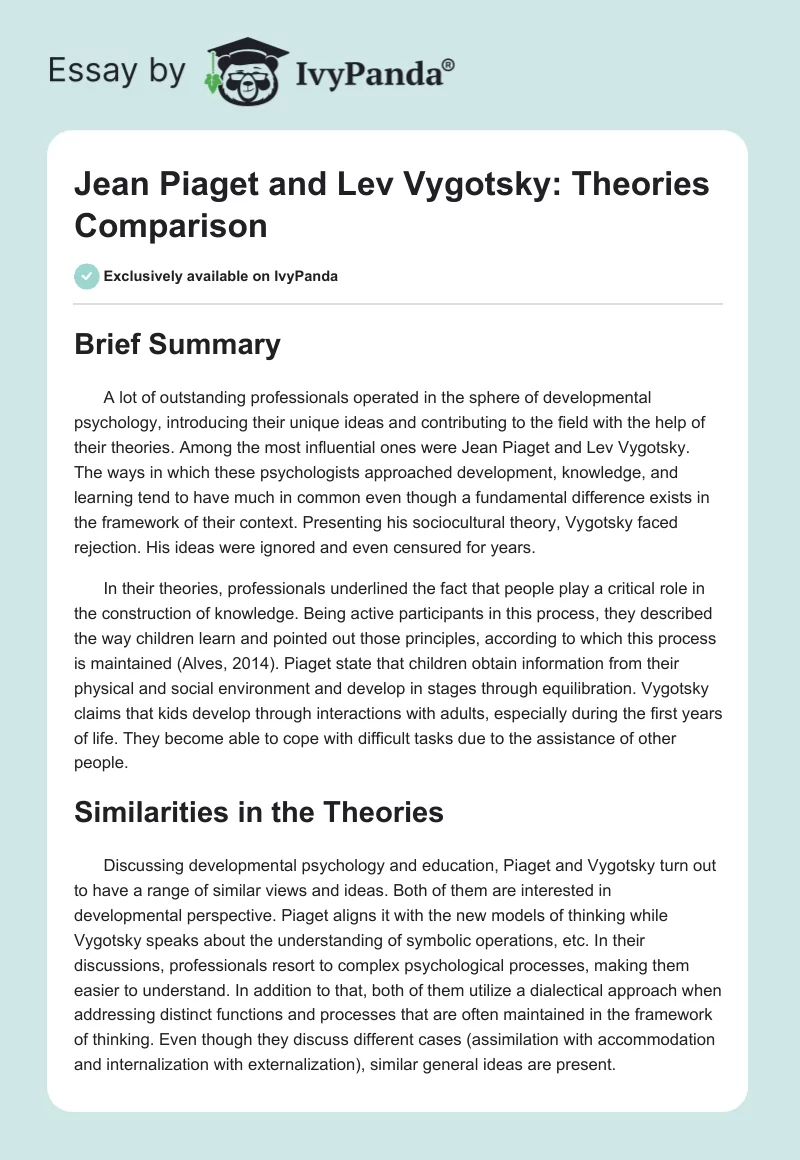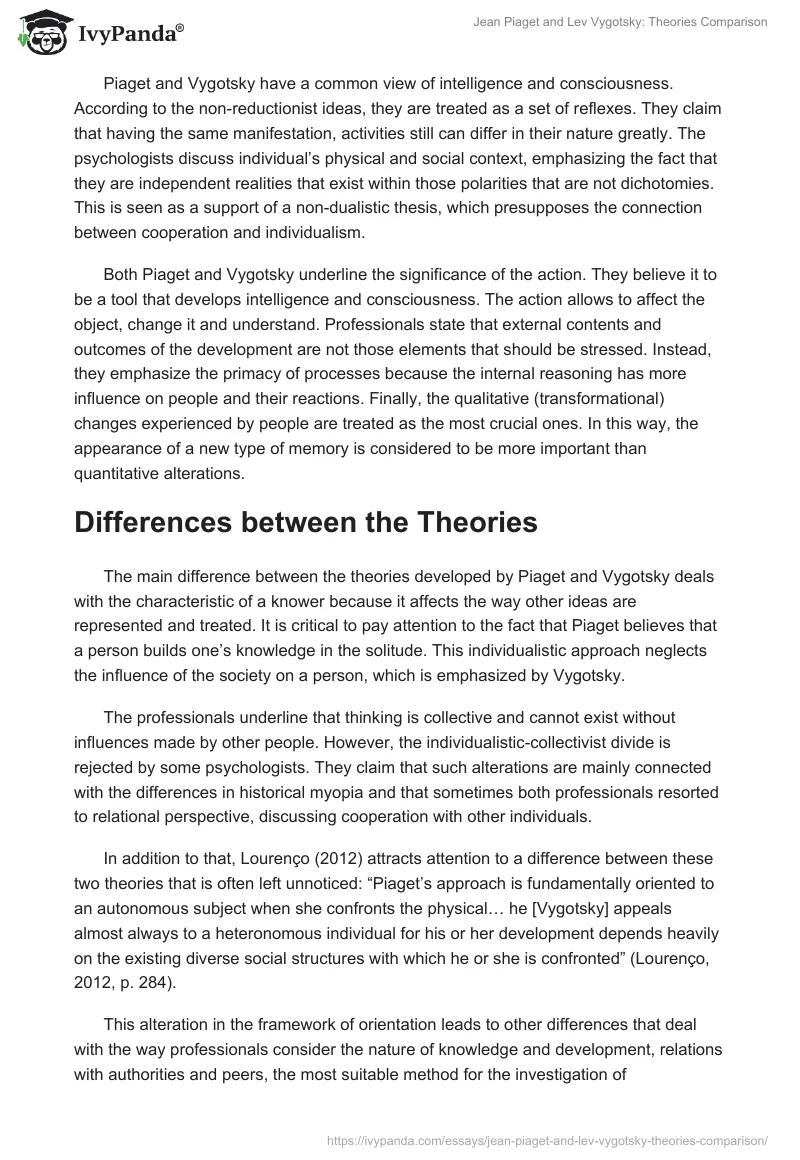Brief Summary
A lot of outstanding professionals operated in the sphere of developmental psychology, introducing their unique ideas and contributing to the field with the help of their theories. Among the most influential ones were Jean Piaget and Lev Vygotsky. The ways in which these psychologists approached development, knowledge, and learning tend to have much in common even though a fundamental difference exists in the framework of their context. Presenting his sociocultural theory, Vygotsky faced rejection. His ideas were ignored and even censured for years.
In their theories, professionals underlined the fact that people play a critical role in the construction of knowledge. Being active participants in this process, they described the way children learn and pointed out those principles, according to which this process is maintained (Alves, 2014). Piaget state that children obtain information from their physical and social environment and develop in stages through equilibration. Vygotsky claims that kids develop through interactions with adults, especially during the first years of life. They become able to cope with difficult tasks due to the assistance of other people.
Similarities in the Theories
Discussing developmental psychology and education, Piaget and Vygotsky turn out to have a range of similar views and ideas. Both of them are interested in developmental perspective. Piaget aligns it with the new models of thinking while Vygotsky speaks about the understanding of symbolic operations, etc. In their discussions, professionals resort to complex psychological processes, making them easier to understand. In addition to that, both of them utilize a dialectical approach when addressing distinct functions and processes that are often maintained in the framework of thinking. Even though they discuss different cases (assimilation with accommodation and internalization with externalization), similar general ideas are present.
Piaget and Vygotsky have a common view of intelligence and consciousness. According to the non-reductionist ideas, they are treated as a set of reflexes. They claim that having the same manifestation, activities still can differ in their nature greatly. The psychologists discuss individual’s physical and social context, emphasizing the fact that they are independent realities that exist within those polarities that are not dichotomies. This is seen as a support of a non-dualistic thesis, which presupposes the connection between cooperation and individualism.
Both Piaget and Vygotsky underline the significance of the action. They believe it to be a tool that develops intelligence and consciousness. The action allows to affect the object, change it and understand. Professionals state that external contents and outcomes of the development are not those elements that should be stressed. Instead, they emphasize the primacy of processes because the internal reasoning has more influence on people and their reactions. Finally, the qualitative (transformational) changes experienced by people are treated as the most crucial ones. In this way, the appearance of a new type of memory is considered to be more important than quantitative alterations.
Differences between the Theories
The main difference between the theories developed by Piaget and Vygotsky deals with the characteristic of a knower because it affects the way other ideas are represented and treated. It is critical to pay attention to the fact that Piaget believes that a person builds one’s knowledge in the solitude. This individualistic approach neglects the influence of the society on a person, which is emphasized by Vygotsky.
The professionals underline that thinking is collective and cannot exist without influences made by other people. However, the individualistic-collectivist divide is rejected by some psychologists. They claim that such alterations are mainly connected with the differences in historical myopia and that sometimes both professionals resorted to relational perspective, discussing cooperation with other individuals.
In addition to that, Lourenço (2012) attracts attention to a difference between these two theories that is often left unnoticed: “Piaget’s approach is fundamentally oriented to an autonomous subject when she confronts the physical… he [Vygotsky] appeals almost always to a heteronomous individual for his or her development depends heavily on the existing diverse social structures with which he or she is confronted” (Lourenço, 2012, p. 284).
This alteration in the framework of orientation leads to other differences that deal with the way professionals consider the nature of knowledge and development, relations with authorities and peers, the most suitable method for the investigation of developmental changes, the essence of true and necessary knowledge, and influences of transformation and transmission on development and learning.
Advantages of a Better Understanding
A better understanding of those issues related to developmental psychology can be obtained if one is aware of the major differences and similarities between the theories developed by Piaget and Vygotsky. As a result, the readers gain a possibility base their personal considerations and conclusions on the basis of various authoritative ideas, which makes final decisions more constructive and valuable.
Being aware of more current interpretations, professionals receive an opportunity to align them with the ideas revealed by Piaget and Vygotsky so that eventually a mixed approach that overcomes existing gaps in these theories can be obtained. Thus, those who know all details of theories developed by Piaget and Vygotsky can improve their knowledge of human development and learning greatly so that they will operate better in practice.
References
Alves, P. (2014). Vygotsky and Piaget: Scientific concepts. Psychology in Russia: State of the Art, 7(3), 24-34. Web.
Lourenço, O. (2012). Piaget and Vygotsky: Many resemblances and a crucial difference. New Ideas in Psychology, 30, 281-295. Web.


